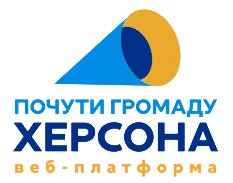Research objective: to assess public support for Kherson urban initiatives and real estate issues.
Sample scope: 402 respondents.
Field stage period: May 1 – 10, 2024.
Research client: Community Foundation of Kherson «Zakhyst».
Key Outputs
1.Most Kherson respondents (71%) believe that Kherson recovery should be focused not on restoring the way it was before the war but on creating a new city. That said, the general vision of the main city restoration concept has not changed since October 2023.

2.Most urban initiatives featuring the European city development were taken positively. The concept of urban space inclusion had the highest support – 97% of respondents believe that all Kherson public buildings should have special installations for people with reduced mobility. More than half also supported the idea of limiting large advertisements (big boards, etc.) use within the city (85%); transforming the historic part of the city into a conservation area to
preserve its original appearance (84%); moving the port-elevator outside the city limits and creating one long embankment from the seaport to the Voienka city district (75%); developing the “Kherson Resident Card” – an embossed
plastic card serving both as a payment card and a cardholder’s data carrier, supporting applications related to the provision and accounting of social assistance and other information functionality and services (71%); prioritizing the development of bicycle transport instead of the automobile one (68%); transforming part of Nezalezhnosti Avenue (Ushakova) into a pedestrian zone on weekends and holidays (58%); removing all outdoor structures (like
kiosks, small shops, trade outlets) in the city (54%). However, initiatives related to reducing the number of vehicles in the city had less support. Only 45% supported the development of paid car parking in the city center, while 47% did not. Almost half of the respondents (48%) also supported the idea of adding one or two lanes to the roadway of Nezalezhnosti Avenue (Ushakova), which could hardly add to the image of a modern city.
3. The damages inflicted on the Kherson residents by the war are growing. Mostly, it is about damaged housing and psychological deterioration. 46% of respondents stated having housing.
4. The housing of 60% of families who owned real estate before the war (which is 87% of respondents) was damaged during the war, and 5% – completely destroyed. Still, 78% of them are not into selling their property. There are by 11% more people wishing to sell their Kherson property among those who have left the city.
5. 16% of all respondents claim that they are considering the issue of buying housing in Kherson. Moreover, there are 10% of such people among those who currently live in Kherson, while among those who have left – 24%. 97% of respondents stated that they do not rent out their housing in Kherson, and 21% – that their family members rent it in Kherson.
6. The said real estate plans evidence both of intentions to return to Kherson and of the real situation in the city. Kherson residents are not ready to get rid of their housing and keep their opinion about the city’s future, its image, and structure, that is, their planning includes the city.
You can read the full report by downloading it or read it in Ukrainian.
This research was conducted by the Zakhyst Kherson Community Foundation Charitable Organization as a part of its project implemented under the USAID/ENGAGE activity, which is funded by the United States Agency for International Development (USAID) and implemented by Pact. The consents of this research are the sole responsibility of Pact and its implementing partners and do not necessary reflect the views of USAID or the United States Government/
Reproducing and using any part of this product in any format, including graphic and electronic, copying or any other usage is suitable to reference to the sourc/




